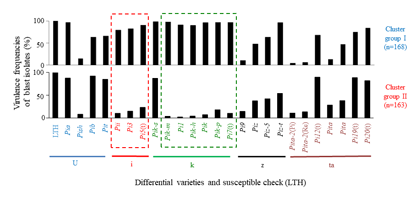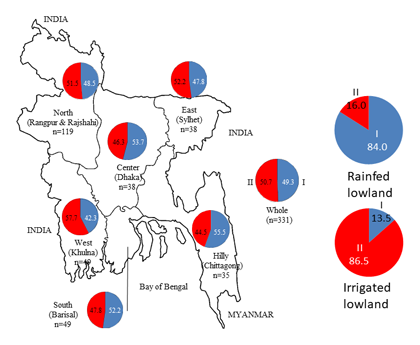Genetic variation in resistance in rice germplasm and differentiation of blast races in Bangladesh
Description
Rice cultivations are conducted under three conditions in Bangladesh, namely, Aus (upland in early rainy season), Aman (rainfed lowland in late rainy season), and Boro (lowland in winter/dry season). Rice blast disease has been reported in recent years, the most serious of which occur during Boro season. Unfortunately, local information related to the genetic variation in resistance of rice cultivars and the differentiation of blast races is scarce. To build up a stable protection system against the disease, the accumulation of relevant information in rice cultivars and blast races will be important.
A total of 331 blast isolates from Bangladesh were classified into two cluster groups, I and II, based on the reaction patterns to differential varieties for 23 kinds of resistance genes (Fig. 1). Those in cluster I showed higher frequencies of virulence to differential varieties (DVs) for Pii, Pi3, Pi5(t), Pik-m, Pi1, Pik-h, Pi-k, Pik-p and Pi7(t) than those in cluster II (Fig.1). Clusters I and II were dominant in rainfed lowland and irrigated lowland, respectively, and there were no major differences between I and II in each region (Fig. 2). The results, however, were different in the case of other countries such as Japan, Cambodia, and West Africa. Blast isolates from rice cultivars BRRI dhan34 and Sadamota in rainfed lowland were virulent to DVs in [i] and [k] groups (except for Pik-s), while those from BRRI dhan28 and BRRI dhan47 in irrigated lowland were avirulent.
On the other hand, 334 rice accessions conserved in Bangladesh Rice Research Institute (BRRI) showed a wide variation in resistance. Variations among the groups in cultivated conditions (Aus, Amam, and Boro) and cultivated groups (Indica Group and Japonica Group) were changed, and showed complexity. BRRI dhan34 and Sadamota (but not BRRI dhan 28 and BRRI dhan 47) were found to harbor the resistance genes in DV groups [i] and [k], but not BRRI dhan 28 and BRRI dhan47.
These results indicated that wide variations in resistance of rice cultivars and blast races were present, and that the differentiation of blast races corresponded with rice cultivars that are cultivated in each region and cultivated condition. This will be the first step in the development of a durable protection system against blast disease in Bangladesh.
Figure, table
-
Fig. 1. Virulence frequencies of blast isolates from each cluster group on differential varieties.
Cluster analysis using Word’s hierarchical clustering method was used to classify a total of 331 blast isolates on the basis of the reaction pattern of 25 differential varieties as well as Lijangxintuanheigu (LTH) for susceptibility checking (Modified from Khan et al. 2017). -
Fig. 2. Geographical distribution of cluster groups for blast isolates in Bangladesh.
There were no big differences in frequencies between clusters I and II in each region, but the frequencies were completely different between rainfed lowland and irrigated lowland. -
〇:indicates presence of resistance gene, 1: indicates presence of any of the resistance genesTable 1. Estimated resistance genes in rice cultivars of Bangladesh Cultivation season Variety Estimated resistance gene in genetic background Differential variety Unknown 「U」 「i」 「k」 「z」 「ta」 Pia Pish Pib Pit Pii
Pi3
Pi5(t)Pik-s Pik-m
Pi1
Pik-h
Pik
Pik-p
Pi7(t)Pi9(t)
Piz
Piz-5
Piz-tPita-2, Pi12(t)
Pita
Pi19(t)
Pi20(t)Aman
(Rainfed)BRRI dhan34 ○ 1 1 1 Sadamota ○ ○ 1 1 1 1 1 Boro
(Irrigated lowland)BRRI dhan28 ○ ○ ○ ○ ○ 1 1 1 BRRI dhan47 ○ ○ ○ ○ 1 1
- Affiliation
-
Japan International Research Center for Agricultural Sciences Tropical Agriculture Research Front
- Research project
- Program name
- Term of research
-
FY2017(2016~2020)
- Responsible researcher
-
Fukuta Yoshimichi ( Tropical Agriculture Research Front )
Yanagihara Seiji ( Biological Resources and Post-harvest Division )
MIERUKA ID: 001780Obara Mitsuhiro ( Biological Resources and Post-harvest Division )
Khan Md. A. I. ( Bangladesh Rice Research Institute )
Monsur M. A. ( Bangladesh Rice Research Institute )
Mia M. A.T. ( Bangladesh Rice Research Institute )
Latif M. A. ( Bangladesh Rice Research Institute )
Khalequzzaman M. ( Bangladesh Rice Research Institute )
Tanaka Akiko ( Tottori University )
Hayashi Nagao ( Institute of Agrobiological Sciences, NARO )
KAKEN Researcher No.: 90391557Tomita Asami ( University of Tsukuba )
- ほか
- Publication, etc.
-
https://doi.org/10.1094/PDIS-12-15-1486-RE
Khan M et al. (2016) Plant Disease, 100: 2025-2033
https://doi.org/10.1270/jsbbs.17039Khan M et al. (2017) Breeding Science
- Japanese PDF
-
A4 307.83 KB
A3 305.48 KB
- English PDF
-
A4 229.56 KB
A3 202.96 KB
- Poster PDF
-
2017_B13_poster.pdf446.36 KB


